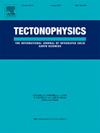青藏高原东南缘断层交汇处显示地震的空间差异地壳变形:微地震识别的 S 波分裂证据
IF 2.7
3区 地球科学
Q2 GEOCHEMISTRY & GEOPHYSICS
引用次数: 0
摘要
青藏高原东南缘三江侧碰撞带(SLCZ)是多条走向滑动断层交汇的特殊区域,变形强烈,地震频繁。我们利用密集的临时宽带阵列(SJ 阵列)和区域永久台站记录的地震波形,通过对 SLCZ 的微震识别,构建了更完整的微震目录。新的微震目录有效地增加了小地震的数量,揭示了断层结构的细节,为S波分裂(SWS)分析提供了更多的记录。新的微地震目录有效地增加了小地震的数量,揭示了断层结构的细节,为S波分裂(SWS)分析提供了更多的记录,为探测SLCZ断层交汇带地壳上部各向异性的细节,剖析漓江-小金河断层和红河断层等断层对地壳变形的影响提供了难得的机会。SWS参数的空间分布表明研究区地壳上部各向异性存在多种扰动机制。块体边界断层附近快速S波双主导极化方向的空间分布揭示了应力聚焦范围。SWS 数据显示的强烈形变表明当地地震活动频繁。这揭示了SWS参数所显示的地壳上部空间变形不仅与应力、断层和局部构造密切相关,而且与局部地震密切相关。本文章由计算机程序翻译,如有差异,请以英文原文为准。
Spatially-varied crustal deformation indicating seismicity at faults intersection in the SE margin of the Tibetan Plateau: Evidence of S-wave splitting from microseismic identification
The Sanjiang Lateral Collision Zone (SLCZ) in the SE margin of the Tibetan Plateau is a special area where several strike-slip faults intersect, resulting in strong deformation and frequent earthquakes. We employ seismic waveforms recorded by a dense temporary broadband array (SJ array) and regional permanent stations to construct more complete microseismic catalogs by the microseismic identification in the SLCZ. New microseismic catalogs effectively increase the number of small earthquakes, revealing the details of the fault structures and providing many more records for S-wave splitting (SWS) analysis. It provides with an uncommon opportunity to detect the detailed upper crustal anisotropy in the fault intersection zone of SLCZ and to dissect the influence of faults, such as the Lijiang-Xiaojinhe fault and Red river fault, on crustal deformation. The spatial distribution of SWS parameters suggests multiple disturbance mechanisms to the upper crustal anisotropy in the study zone. Spatial distribution of dual dominant polarization directions of fast S waves near the block boundary faults uncovers the stress-focus range. Strong deformation from SWS data indicates frequent local seismicity. It reveals the spatial upper crustal deformation indicated by SWS parameters is closely related to not only stress, fault and local structure, but also local seismicity.
求助全文
通过发布文献求助,成功后即可免费获取论文全文。
去求助
来源期刊

Tectonophysics
地学-地球化学与地球物理
CiteScore
4.90
自引率
6.90%
发文量
300
审稿时长
6 months
期刊介绍:
The prime focus of Tectonophysics will be high-impact original research and reviews in the fields of kinematics, structure, composition, and dynamics of the solid arth at all scales. Tectonophysics particularly encourages submission of papers based on the integration of a multitude of geophysical, geological, geochemical, geodynamic, and geotectonic methods
 求助内容:
求助内容: 应助结果提醒方式:
应助结果提醒方式:


